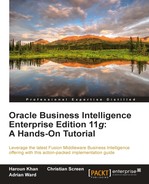Book Description
Utilizing the full potential of the Oracle Business intelligent Enterprise Edition is in easy reach with this tutorial. From first principles right through to developing your own tools, it’s the complete guide for beginners and intermediates.
- Get to grips with the OBIEE 11g suite for analyzing and reporting on your business data
- Immerse yourself in BI upgrading techniques, using Agents and the Action Framework and much more in this book and e-book
- A practical, from the coalface tutorial, bursting with step by step instructions and real world case studies to help you implement the suite’s powerful analytic capabilities
In Detail
The Oracle Business Intelligence Enterprise Edition 11g (OBIEE) suite delivers a full range of analytic and reporting capabilities, coupled with powerful user experience for creating reports, dashboards and more with your business data. "Oracle Business Intelligence Enterprise Edition 11g: A Hands-On Tutorial" will have you unleashing that power in no time, helping you to take action and make the right decisions ataglance.
"Oracle Business Intelligence Enterprise Edition 11g: A Hands-On Tutorial" provides you with valuable insight and the step-by-step know-how you need to take advantage of everything the Oracle BI suite has to offer you, all utilizing real world case studies for a true implementation in action.
"Oracle Business Intelligence Enterprise Edition 11g: A Hands- on Tutorial" takes you on a journey right from inception to a full working OBI 11g System. Using a real-world data walkthrough you’ll explore topics like architecture, reporting and leveraging Essbase as a data source, as well as building the Oracle BI 11g metadata repository (RPD), and developing reports and dashboards in the new Fusion Middleware interface. This practical implementation guide equips you with from the coalface advice which will help you achieve a successful working application by journey’s end.
Table of Contents
- Oracle Business Intelligence Enterprise Edition 11g: A Hands-On Tutorial
- Oracle Business Intelligence Enterprise Edition 11g: A Hands-On Tutorial
- Credits
- About the Authors
- About the Reviewers
- www.PacktPub.com
- Preface
- 1. Understanding the Oracle BI 11g Architecture
- Looking backward and looking forward
- Let's look at the big picture
- What is Oracle Fusion Middleware?
- An application server by any other name
- A database repository — for what?
- Overall components
- WebLogic Server
- Oracle Process Management and Notification system
- Security
- System requirements
- Scaling out Oracle BI 11g
- Directory folder structure
- A review — what I should now know!
- Additional research suggestions
- Summary
- 2. Installing the Metadata Repository
- 3. Installing on Windows Server 2008
- 4. Installation Options
- 5. Understanding the Systems Management Tools
- Let's talk about management tools
- WebLogic Server Administration Control
- Using WLST
- Enterprise Manager Fusion Middleware Control
- Creating the Tennis users, roles, and associations
- Configuring an LDAP identity provider in WLS
- JMX, MBeans, and Java
- Migrating FMW Security to other environments
- Oracle BI Publisher system management
- Monitoring system performance
- Have a backup plan!
- Recommendations for further learning
- A review — what I should now know!
- Summary
- 6. Upgrading the RPD and Web Catalog to 11g
- 7. Reporting Databases
- 8. Developing a BI Repository
- 9. Features of the Presentation Catalog
- 10. Creating Dashboards and Analysis
- 11. Agents and the Action Framework
- 12. Developing Reports Using BI Publisher
- Don't miss the installation integration checkpoint!
- Where BI Publisher excels?
- Yes, BI Publisher is now Published Reporting
- Oracle BI Foundation versus Oracle BI Publisher
- New features and enhancements
- Report design basics, terminology, and locations
- Let's get publishing
- Auditing and monitoring BI Publisher
- BI Publisher nuances
- A review — what I should now know!
- Additional research suggestions
- Summary
- 13. Customizing the Style of Dashboards
- What's the idea?
- Multiple skins and styles in one environment
- A strategy for something seemingly simple
- General knowledge and tools
- Third-party tools
- Hands-on — go time!
- Developing/designing a new look and feel
- Advanced learning topics
- A review — what I should now know!
- Summary
- 14. Improving the Performance
- 15. Using the BI Admin Change Management Utilities
- 16. Usage Tracking
- 17. Oracle Essbase and OLAP Integration
- A bit about OLAP
- Oracle Essbase Studio
- Oracle BI SampleApp v107+ VM image
- Getting started — let's get set up
- Modeling Essbase into Oracle BI
- Federation of data
- Oracle BI/EPM roadmap
- A review — what I should now know!
- Additional research suggestions
- Summary
- A. Programs and Definitions
- B. Useful Resources: Join the Oracle BI Movement
